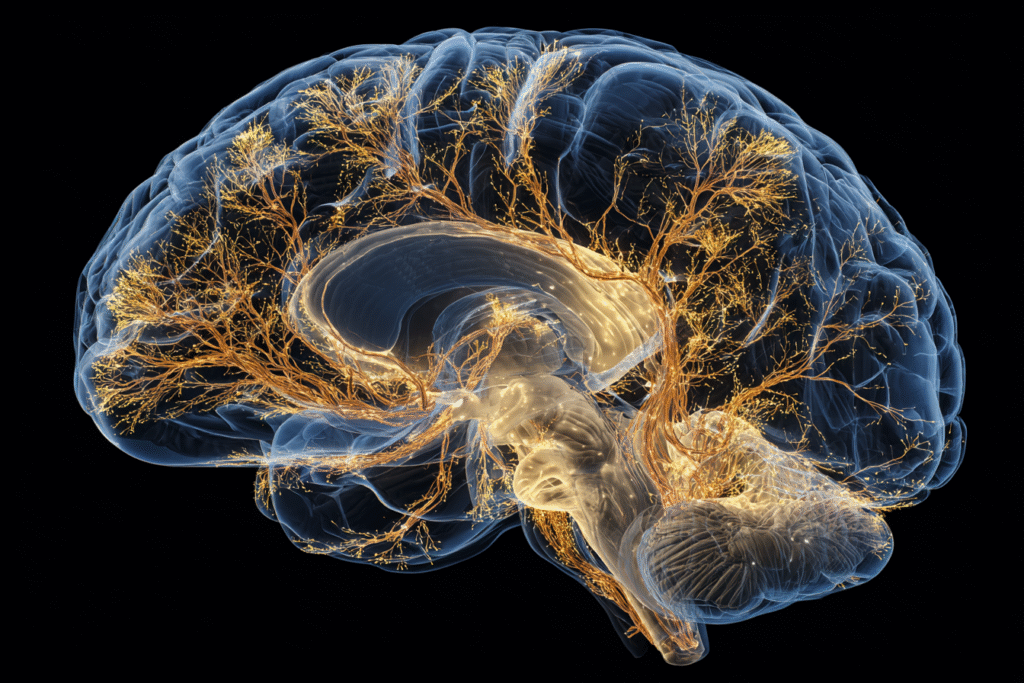The most advanced healing technology available requires no subscription, no device, and no expertise—just your willingness to speak to the divine.
Note: This article is for educational and informational purposes only. See full disclaimer at the end.
While scientists debate prayer’s mechanisms and theologians wrestle with its mysteries, millions of people worldwide experience something undeniable: prayer transforms both body and spirit in ways that modern medicine is only beginning to understand. This isn’t about proving God’s existence through brain scans or reducing sacred communication to neurochemical reactions. This is about recognizing that prayer, like meditation before it, has measurable effects on human health that deserve our attention, respect, and systematic exploration.
The fascinating intersection of ancient spiritual practice and cutting-edge neuroscience reveals that prayer offers tangible benefits for cardiovascular health, immune function, pain management, and neuroplasticity. Whether you approach prayer from deep religious conviction or scientific curiosity, the evidence suggests that this fundamental human practice may be one of our most underutilized health resources.

The Scientific Foundation of Prayer's Power
The study of prayer in medical contexts began seriously in the 1870s when Irish physicist Francis Galton proposed comparing healing rates in prayed-for versus non-prayed-for hospital wards. Though his original experiment was deemed too controversial to conduct [1], it sparked a debate that continues today with increasingly sophisticated methodologies.
What Galton couldn’t have anticipated was how modern neuroscience would validate his intuition about prayer’s measurable effects. Today’s brain imaging technology reveals exactly what he suspected: prayer creates observable, quantifiable changes in human physiology—not through mysterious mechanisms, but via well-understood biological pathways that science can now map with precision.
Modern research reveals prayer’s most consistent benefits occur in the person doing the praying, not necessarily in distant recipients of prayer [1]. Harvard cardiologist Herbert Benson, who conducted the landmark “Great Prayer Experiment,” found that prayer produces measurable effects on metabolism, heart rate, blood pressure, breathing rate, and brain activity, leading him to conclude that “we got scientific proof that prayer affects body functions and fights stress.”
This scientific validation hasn’t been without challenges. Prayer research faces unique methodological difficulties that distinguish it from other health interventions. Unlike medication studies, prayer cannot be easily standardized, double-blinded, or quantified in terms of dosage [2]. Yet despite these limitations, consistent patterns emerge across studies examining prayer’s physiological and psychological effects.
A systematic literature review analyzing 12 studies found that prayer served as a positive factor in seven studies, with benefits including reduced anxiety in mothers of children with cancer, decreased inflammatory markers, and improved pain tolerance [3]. These findings suggest that prayer’s health benefits extend across diverse populations and medical conditions.
The Heart of Prayer
Perhaps the most robust evidence for prayer’s health benefits comes from cardiovascular research. Studies consistently show that regular prayer practice correlates with improved heart health, including reduced blood pressure, enhanced heart rate variability, and improved cardiac autonomic function.
The famous Bernardi study published in the British Medical Journal demonstrated that praying the rosary at six recitations per minute significantly enhanced cardiovascular rhythms and increased baroreflex sensitivity in cardiovascular patients [4]. This optimal prayer rate of six breaths per minute aligns precisely with the body’s natural Mayer waves—10-second blood pressure cycles that indicate healthy autonomic nervous system function.
Research shows that people who pray daily are 40% less likely to develop high blood pressure compared to those who don’t pray. Heart surgery patients with strong religious beliefs and prayer practices showed three times greater recovery rates than non-religious patients, suggesting prayer’s protective effects extend beyond prevention into acute medical scenarios.
The cardiovascular benefits appear to work through multiple mechanisms. Prayer activates the relaxation response, which counteracts stress-induced damage to blood vessels and heart muscle. Additionally, the rhythmic breathing patterns inherent in many prayer forms help synchronize cardiovascular rhythms, promoting optimal heart function and circulation.

Prayer as Biological Defense
Recent research reveals that prayer significantly enhances immune system functioning through several interconnected pathways. A groundbreaking study published in Scientific Reports found that individuals engaged in regular prayer or meditation showed lower levels of autoantibodies and reduced inflammatory markers [5]. Among patients with autoimmune conditions, those with spiritual practices demonstrated better disease activity scores and reduced symptoms.
Prayer appears to enhance immune function by reducing stress hormones that suppress immune response. Studies show that regular prayer practice correlates with decreased cortisol levels—the primary stress hormone that, when chronically elevated, weakens immune defenses [6]. Islamic prayer (Namaz) research demonstrates that even a single prayer session can reduce cortisol levels in individuals with elevated baseline stress markers.
The immune benefits extend to inflammatory processes throughout the body. Prayer practitioners show reduced levels of pro-inflammatory cytokines like interleukin-6, which play crucial roles in chronic diseases and autoimmune conditions [5]. This anti-inflammatory effect appears to work through prayer’s ability to activate positive emotions like gratitude, hope, and compassion, which have direct anti-inflammatory properties.
Scientific studies indicate that long-term daily prayer helps deactivate genes that trigger inflammation and cellular death, essentially providing genetic-level protection against disease processes [6]. This genetic modulation suggests that prayer’s benefits may extend beyond immediate physiological effects to long-term health preservation.
Neuroplasticity and Brain Transformation
Perhaps the most fascinating prayer research emerges from neuroscience laboratories, where brain imaging reveals how prayer literally reshapes neural architecture. Dr. Andrew Newberg’s pioneering neurotheology research demonstrates that people who engage in regular prayer show distinct brain patterns compared to non-practitioners.
Brain scans of people deep in prayer reveal increased activity in the frontal lobes—areas responsible for attention, focus, and emotional regulation [15]. Simultaneously, activity decreases in the parietal lobes, regions that maintain our sense of self and spatial orientation. This neurological pattern correlates with the subjective experience of transcendence and unity that many people report during prayer.
Long-term prayer practitioners develop measurably thicker frontal lobes, indicating enhanced concentration abilities and emotional regulation capacity [16]. This neuroplasticity occurs because prayer, like physical exercise, strengthens the neural pathways it repeatedly activates.
Individuals who pray frequently demonstrate superior control over their brain activity [7]. Neurofeedback studies confirm that regular prayer strengthens self-awareness and attention regulation, suggesting that prayer develops meta-cognitive abilities that transfer to other life domains.
Research shows that just 12 minutes of focused prayer daily over eight weeks can measurably reshape brain structure and emotional patterns. These changes include enhanced neural connections associated with positive emotions and weakened pathways linked to anxiety and negative thinking patterns.
These brain changes translate into practical health applications, particularly in one area where prayer’s benefits are both immediate and measurable: pain management.

Pain Management Through Prayer
Prayer offers a powerful, non-pharmacological approach to pain management that works through multiple mechanisms. Systematic reviews reveal that active prayer practices significantly reduce both pain intensity and pain-related distress across various conditions [8]. Pain clinic patients report prayer as their second most frequent response to pain, after taking medication.
The pain relief mechanisms appear to involve both psychological and neurological pathways. Prayer functions as a positive reappraisal technique, helping people identify meaning and growth opportunities within painful experiences rather than focusing solely on suffering [9].
This cognitive reframing significantly enhances pain tolerance—studies show prayer-based reappraisal techniques can increase pain endurance in controlled laboratory settings, with some research indicating improvements of 40-90% in pain tolerance measures [9].
Neuroimaging studies reveal that prayer reduces activity in brain regions associated with pain processing while enhancing areas linked to positive emotion and coping [10]. Prayer appears to provide natural pain relief by activating the brain’s endogenous opioid systems—the body’s internal pain management mechanisms.
Research distinguishes between different prayer approaches for pain management. Active prayer, where individuals seek strength to cope with pain, shows superior outcomes compared to passive prayer, where people simply request pain removal [10]. This suggests that prayer’s effectiveness depends partly on how we frame our relationship with suffering and healing.
While individual prayer offers powerful pain relief, emerging research reveals that prayer’s benefits compound when practiced in relationship with others.
The Power of Collective Prayer
Whether shared in families, partnerships, or congregations, collective prayer strengthens not only emotional bonds but also cooperative mindsets. Studies show couples who pray together report greater relationship satisfaction, reduced conflict, and deeper emotional connection [11].
Research on intercessory prayer (praying for others) shows mixed effects on recipients, but consistent benefits for those praying—such as reduced stress, enhanced empathy, and stronger social bonds. Even distant prayer, when done in community settings, has been shown to improve emotional resilience and mutual support.
These communal benefits reinforce traditional wisdom: the couple that prays together, stays together—and by extension, so do families and communities anchored in shared spiritual practice.
A meta-analysis of 23 studies involving 2,774 patients found that 13 studies showed statistically significant positive results for distant prayer effects, though the overall evidence remains inconclusive for recipients.
More promising research focuses on the prayer community itself. Studies of couples participating in intercessory prayer interventions found that those in prayer groups showed improved relationship outcomes, suggesting that group prayer creates lasting positive changes in participants [14]. These findings support the traditional wisdom that “the couple that prays together, stays together.”
These collective aspects may explain why group worship environments often feel energetically different. While we can’t yet quantify “sacred energy,” research shows group prayer alters participants’ stress and emotional states in meaningful, measurable ways.

Sacred Spaces and Environmental Factors
While prayer transcends location, research on therapeutic landscapes confirms that environmental factors influence prayer effectiveness and physiological outcomes [12]. The key isn’t finding sacred geography—it’s creating conditions that enhance prayer’s measurable health benefits.
Elements that amplify prayer’s biological effects:
- Consistency: Using the same space trains your nervous system to enter contemplative states faster
- Acoustic quality: Quiet or consistent background sounds reduce cortisol response
- Visual simplicity: Minimal distractions allow deeper focus, enhancing neuroplasticity benefits
- Physical comfort: Proper temperature and seating support parasympathetic activation
Ancient sacred sites demonstrate remarkable continuity across cultures, but research shows any space becomes “sacred” through repeated spiritual engagement. This democratizes transformative prayer, making it accessible regardless of access to traditional religious buildings.
Prayer Types and Approaches
Scientific research reveals that different prayer approaches produce distinct physiological and psychological effects. Understanding these differences can help individuals optimize their prayer practice for specific health goals.
Meditative Prayer involves focusing on specific words, phrases, or breathing patterns. This approach shows the strongest cardiovascular benefits, particularly when practiced at rates that synchronize with natural biological rhythms [4]. The rosary tradition exemplifies this approach, with its rhythmic prayer pattern producing measurable improvements in heart rate variability and blood pressure regulation.
Intercessory Prayer focuses on others’ wellbeing and shows particular benefits for the person praying. Research demonstrates that praying for others activates brain regions associated with empathy and compassion while reducing areas linked to self-centered thinking [15]. This type of prayer enhances social bonding and cooperative behavior, with measurable improvements in relationship quality.
Contemplative Prayer emphasizes listening and receptivity rather than petitioning. Brain imaging shows this approach increases activity in areas associated with self-reflection and inner awareness while decreasing activity in regions linked to external attention [16]. This pattern promotes introspection and emotional processing.
Gratitude-Based Prayer focuses on thanksgiving and appreciation. This approach is especially effective at enhancing positive emotions and reducing inflammation [5]. Gratitude practices activate reward systems in the brain while suppressing stress-related neural activity.
The key finding across prayer types is that effectiveness depends on genuine engagement rather than mechanical repetition [13]. Prayer functions as collaborative problem-solving with the divine, requiring active participation and emotional investment to produce optimal health benefits.
Understanding these different approaches provides the foundation for building a systematic practice. The key is translating this research into daily implementation that fits your life and amplifies these proven benefits.

Structured Prayer Practice for Health
Creating an effective prayer practice for health benefits requires understanding both the spiritual and physiological aspects of this ancient practice. Research suggests that consistency and duration matter more than perfect technique or elaborate rituals.
Start with Rhythm and Breath
The strongest cardiovascular effects appear when breathing slows to ~6 breaths per minute. Traditional prayer forms—like the rosary, Islamic prayer, or Orthodox chants—naturally guide practitioners to this rhythm [4]. Focus on breath depth and cadence, not perfection.
Consistency Over Perfection
Science shows that 12 minutes per day over 8 weeks creates real brain changes [16]. Choose a daily anchor—like morning or bedtime—and focus on showing up more than getting it “right.” Even short sessions carry benefits.
Rotate Prayer Types
Switching between meditative, intercessory, contemplative, and gratitude-based prayer prevents stagnation and engages different neural circuits. Let each prayer serve its purpose. Simplicity invites consistency.
Environment as Anchor
Create a consistent place for prayer: clean, quiet, minimally distracting. Add meaningful symbols or music if helpful. Familiarity trains your nervous system to enter reverence faster [12].
Track Your Response
Use a simple log to track subjective changes (stress, mood, sleep) and objective metrics (blood pressure, pain). This reinforces motivation and helps refine your approach.
Expect Resistance
Distraction, dryness, or doubt are normal. Start small. Use guides, structured apps, or written prayers until flow comes more naturally [10].
Build Gradually
Week 1–2: Anchor the habit (5–10 mins/day)
Week 3–4: Expand to 10–15 mins, explore prayer types
Week 5–8: Add variety, strengthen routine, refine space
Week 9–12: Invite others in, explore deeper traditions
Ongoing: Flex with life. A missed day doesn’t break you—return gently.
Prayer and Stress Management
Prayer reduces stress through multiple biological pathways now being mapped by science. These mechanisms explain why prayer produces measurable health benefits regardless of one’s theological beliefs about divine intervention.
Prayer activates the parasympathetic nervous system—the “rest and digest” response that counteracts chronic stress activation. This shift reduces cortisol production, lowers blood pressure, and enhances immune function. The physiological changes mirror those produced by meditation, but prayer often feels more accessible to people who struggle with traditional mindfulness practices.
Islamic prayer research reveals particularly detailed stress reduction mechanisms. Studies show that single prayer sessions can significantly reduce cortisol levels in individuals with elevated baseline stress markers [6]. The study also found decreased expression of inflammatory genes (BDNF), suggesting that prayer influences genetic activity related to stress and inflammation.
Prayer’s stress management benefits appear strongest for individuals facing significant life challenges. Research during the COVID-19 pandemic showed that 55% of U.S. adults turned to prayer for stress management, with many reporting it as more effective than other coping strategies. This suggests prayer provides particular value during acute stress periods.
The stress reduction occurs through both cognitive and physiological mechanisms. Cognitively, prayer helps reframe difficult situations by connecting them to larger meaning and purpose [9]. Physiologically, prayer reduces activity in the amygdala—the brain’s alarm system—while enhancing prefrontal cortex function associated with emotional regulation and decision-making.

Technology and Prayer
While prayer’s power lies in its simplicity and accessibility, modern technology offers tools that can enhance traditional prayer practices without replacing their essential human elements. This integration represents an evolution rather than a revolution in spiritual practice.
Prayer apps like Hallow, PrayerMate, and Abide provide structure, reminders, and community connection for those developing prayer habits. These applications show particular value for busy individuals who struggle with consistency or need guidance in prayer variety. However, research emphasizes that the app’s effectiveness depends on genuine engagement rather than passive consumption.
Some practitioners find prayer tracking helpful for maintaining consistency and recognizing patterns in their spiritual practice. Digital tools can organize prayer lists, set reminders for intercession, and provide progress feedback. However, the measurable benefits of prayer appear to depend on heart engagement rather than technical optimization.
Biofeedback devices that monitor heart rate variability, breathing patterns, or brain waves can provide real-time feedback about prayer’s physiological effects [16]. Some practitioners find this feedback encouraging, particularly when beginning prayer practice or working through periods of spiritual dryness.
The key principle for technology integration is enhancement rather than replacement. Prayer’s true power comes from direct communion with the divine—not from digital mediation. Technology works best when it supports traditional prayer elements—consistency, community, and contemplation—rather than attempting to digitize the sacred itself.
Prayer Skepticism: Science and Faith
Many scientifically-minded individuals hesitate to explore prayer’s health benefits due to concerns about mixing empirical evidence with spiritual belief. This skepticism is understandable but may prevent access to demonstrated health interventions.
The scientific approach to prayer focuses on measurable outcomes rather than theological claims. Researchers can study prayer’s effects on blood pressure, immune markers, brain activity, and psychological wellbeing without making claims about divine intervention or supernatural mechanisms. This approach allows evidence-based evaluation while respecting individual beliefs about prayer’s spiritual dimensions.
Importantly, prayer’s health benefits appear to occur regardless of specific religious beliefs or theological sophistication. Studies show that atheists engaging in contemplative practices similar to prayer achieve many of the same neurological benefits as devoutly religious practitioners. The key appears to be focused attention, rhythmic breathing, and engagement with something larger than immediate concerns.
Prayer should not be viewed as alternative medicine or replacement for conventional healthcare. Instead, research supports prayer as a valuable complementary practice that enhances overall health while supporting medical treatment [3]. This integration approach respects both scientific medicine and spiritual practice without requiring conflict between them.
The most honest scientific position acknowledges prayer’s measurable benefits while remaining appropriately humble about the mechanisms involved. As one researcher noted, “Prayer may not move rocks, but it often inspires people to move rocks”—emphasizing prayer’s role in transforming the person praying rather than directly altering external circumstances.

Prayer as Systematic Health Practice
Approaching prayer as health practice requires balancing systematic implementation with spiritual authenticity. The goal is not to reduce prayer to technique but to optimize its natural health benefits through informed practice.
Morning Foundation: Research suggests starting each day with prayer provides optimal stress management throughout the day. Morning prayer helps establish parasympathetic nervous system activation before daily stressors accumulate. Even five minutes of focused prayer can measurably reduce cortisol levels and enhance emotional regulation capacity.
Transition Prayers: Use brief prayer moments during daily transitions—before meals, entering new environments, or beginning challenging tasks. These micro-practices help maintain stress management throughout the day while building prayer consistency without requiring large time commitments.
Evening Integration: Conclude each day with gratitude-focused prayer to process daily experiences and promote restorative sleep. Research shows prayer before bedtime can improve sleep quality by reducing anxious rumination and activating calming neurotransmitters.
Crisis Support: Develop specific prayer approaches for high-stress situations, acute illness, or emotional challenges. Having established prayer practices provides immediate access to stress management tools during difficult periods when developing new coping strategies may be impossible.
Community Integration: When possible, engage in group prayer or prayer partnerships to amplify prayer’s social and emotional benefits [11]. This might involve family prayer, prayer groups, or even distant prayer partnerships that provide mutual support and accountability.
Integration with Existing Health Frameworks
Prayer practice integrates naturally with the health optimization frameworks established throughout this series, particularly the PEACE framework and Four Foundational Systems approach developed in previous articles.
PEACE Framework Integration: Prayer supports each element of the PEACE framework—Presence (mindful awareness), Embodiment (physical stress reduction), Agency (personal empowerment), Clarity (mental focus), and Expression (authentic communication). Prayer practice enhances all five components while adding spiritual dimension to health optimization.
Four Foundational Systems Enhancement: Prayer directly benefits three of the four foundational health systems. For sleep, evening prayer promotes relaxation and reduces anxious rumination. For stress management, prayer provides immediate and long-term stress reduction tools. For movement, many prayer traditions include physical elements like walking, bowing, or prostration that enhance embodied spiritual practice.

Timing Intelligence: Prayer practice develops sensitivity to personal rhythms and optimal timing for different spiritual approaches. Morning prayer may focus on intention-setting and strength-seeking, while evening prayer emphasizes gratitude and release. This temporal awareness enhances the timing intelligence developed in previous articles.
Health Intuition Development: Regular prayer practice enhances the Four Dimensions of Health Intuition by developing inner awareness, emotional sensitivity, pattern recognition, and wisdom integration. Prayer provides structured practice for tuning into subtle internal signals that inform health decisions.
The integration approach respects prayer’s spiritual nature while leveraging its health benefits within a comprehensive wellness strategy. This allows individuals to honor their faith traditions while optimizing their physical and mental wellbeing through evidence-based practices.
The Future of Prayer and Health
As our understanding of prayer’s health mechanisms deepens, we may see increased integration of spiritual practices into conventional healthcare. This evolution requires careful balance between respecting prayer’s sacred nature and leveraging its therapeutic potential.
Medical institutions increasingly recognize spirituality’s role in patient outcomes, with some hospitals employing chaplains and incorporating prayer into treatment protocols [3]. This integration acknowledges that human health involves biological, psychological, social, and spiritual dimensions that work synergistically.
Personalized medicine may eventually include spiritual practice recommendations based on individual genetic, psychological, and cultural factors. Research suggests that prayer’s effectiveness varies among individuals, possibly due to genetic differences in stress response, neurotransmitter function, or spiritual sensitivity.
The key principle for future development is maintaining prayer’s essential character while optimizing its health applications. Prayer’s power emerges from its spiritual authenticity rather than technical optimization. Any advancement must preserve the relationship between human and divine that forms prayer’s foundation.
As we continue exploring consciousness, spirituality, and health optimization, prayer represents a bridge between ancient wisdom and modern science. It offers a practice that requires no special training, expensive equipment, or complex protocols—just the willingness to engage with the sacred in ways that transform both spirit and body.

Prayer as Daily Health Infrastructure
The scientific evidence reveals prayer as sophisticated health technology operating through multiple biological pathways. From cardiovascular optimization to immune enhancement, from neuroplasticity to stress management, prayer produces measurable benefits that complement conventional healthcare.
Prayer’s greatest advantage lies in its accessibility. Unlike health interventions requiring specialized knowledge or significant investment, prayer is universally available. This democratization represents a profound resource for reducing health disparities and enhancing wellbeing across all populations.
The research challenges us to reconsider prayer not as desperate plea, but as fundamental health infrastructure—a daily practice maintaining biological, psychological, and spiritual resilience. Like exercise, nutrition, and sleep, prayer profoundly influences health outcomes through consistent engagement.
Your next step is simple: Choose one prayer type from this article and commit to 12 minutes daily for the next two weeks. Track your sleep quality, stress levels, or pain—whatever health metric matters most to you right now. Let the research guide your curiosity, but let your experience guide your practice.
Whether you approach this from religious conviction, scientific curiosity, or pragmatic health optimization, the evidence suggests prayer deserves consideration in comprehensive wellness approaches. In our age of complex medical technologies, prayer reminds us that powerful healing tools remain simple, free, and immediately available.
The most advanced healing technology requires no subscription—just your willingness to speak to the divine.
See you in the next insight.
Comprehensive Medical Disclaimer: The insights, frameworks, and recommendations shared in this article are for educational and informational purposes only. They represent a synthesis of research, technology applications, and personal optimization strategies, not medical advice. Individual health needs vary significantly, and what works for one person may not be appropriate for another. Always consult with qualified healthcare professionals before making any significant changes to your lifestyle, nutrition, exercise routine, supplement regimen, or medical treatments. This content does not replace professional medical diagnosis, treatment, or care. If you have specific health concerns or conditions, seek guidance from licensed healthcare practitioners familiar with your individual circumstances.
References
The references below are organized by study type. Peer-reviewed research provides the primary evidence base, while systematic reviews synthesize findings across multiple studies for broader perspective.
Peer-Reviewed / Academic Sources
- [1] Templeton Foundation (2025). What Can Science Say About the Study of Prayer? https://www.templeton.org/news/what-can-science-say-about-the-study-of-prayer
- [2] Masters, K. (2020). The Science of Prayer. Psychological Science. https://www.psychologicalscience.org/news/the-science-of-prayer-2.html
- [3] Gonçalves, J. P., et al. (2016). The Effect of Prayer on Patients’ Health: Systematic Literature Review. Religions. https://www.mdpi.com/2077-1444/7/1/11
- [4] Bernardi, L., et al. (2001). Effect of rosary prayer and yoga mantras on autonomic cardiovascular rhythms: comparative study. British Medical Journal. https://www.bmj.com/content/323/7327/1446
- [5] Módis, L. V., et al. (2024). Spirituality is associated with immune parameters and disease activity in primary Sjögren’s syndrome: a cross-sectional study. Scientific Reports. https://www.nature.com/articles/s41598-024-62801-w
- [6] Hatef, B., et al. (2022). Islamic praying changes stress-related hormones and genes. PMC. https://pmc.ncbi.nlm.nih.gov/articles/PMC9126458/
- [7] Kober, S. E., et al. (2017). Ability to Gain Control Over One’s Own Brain Activity and its Relation to Spiritual Practice: A Multimodal Imaging Study. PMC. https://pmc.ncbi.nlm.nih.gov/articles/PMC5442174/
- [8] Illueca, M. & Doolittle, B. R. (2020). The Use of Prayer in the Management of Pain: A Systematic Review. Journal of Religion and Health. https://link.springer.com/article/10.1007/s10943-019-00967-8
- [9] Dezutter, J., et al. (2011). Prayer and pain: the mediating role of positive re-appraisal. PMC. https://pmc.ncbi.nlm.nih.gov/articles/PMC6689415/
- [10] Meints, S. M., et al. (2023). Pain and PRAYER Scale (PPRAYERS): development and validation of a scale to measure pain-related prayer. Pain Medicine. https://academic.oup.com/painmedicine/article/24/7/862/7048678
- [11] Salas-Wright, C. P., et al. (2019). The Influence of Prayer and Family Worship on Relationship Functioning among Married Adults in the Caribbean and Latin American. Religions. https://www.mdpi.com/2077-1444/11/1/14
- [12] Gesler, W. M. (2003). Therapeutic landscapes: medical issues in light of the new cultural geography. PMC. https://pmc.ncbi.nlm.nih.gov/articles/PMC4352605/
- [13] Kimball, C. N., et al. (2024). Prayer as collaborative problem solving: Testing a new conceptual model. Psychology of Religion and Spirituality. https://www.tandfonline.com/doi/full/10.1080/2153599X.2024.2349778
Government / Institutional Sources
- [14] Templeton Foundation (2024). The Surprising Power of Prayer in Relationships. https://www.templeton.org/news/research-the-surprising-power-of-prayer-in-relationships
Industry / Technology Sources
- [15] Newberg, A. (2009). Prayer May Reshape Your Brain … And Your Reality. NPR. https://www.npr.org/2009/05/20/104310443/prayer-may-reshape-your-brain-and-your-reality
- [16] Newberg, A. (2022). How Prayer Changes Your Brain. Spirituality+Health. https://www.spiritualityhealth.com/how-prayer-changes-your-brain


